Biological Control Methods Against Grapevine Pests and Diseases
- Biological Control
-
- Commodity name: Biological Control Methods Against Grapevine Pests and Diseases
Grapes are a valuable crop for many growers, providing not only delicious fruit but also the foundation for wine production. However, grapevines are susceptible to a variety of pests and diseases that can severely impact yield and quality. Common pests such as grapevine moths, mealybugs, and spider mites can damage leaves, stems, and fruit, hampering the plant’s growth and productivity. Additionally, diseases like powdery mildew of grapes, downy mildew, and Botrytis bunch rot pose significant threats, causing grape leaf disease, fruit rot, and vine decline. Proper identification, monitoring, and management of these pests and diseases are essential for maintaining healthy grapevines and ensuring a successful harvest. In this blog, we’ll delve into the various pests and diseases that affect grapevines and explore effective strategies for managing them. Continue reading to learn more about various grapes diseases and pests from these common threats.
Grapes Pests
Grapes Plant diseases
Esca (Complex of fungi including Phaeoacremonium and Phaeomoniella spp.)
Grapes Nutrition
Grapes Pests
Grape Berry Moth (Lobesia botrana)
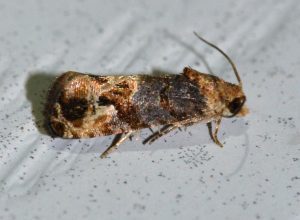
Features:
Grape Berry Moth (Lobesia botrana) is a significant common vineyard pests, known for its ability to damage grape clusters. The moth is small, with a wingspan of about 0.3 to 0.4 inches, and has distinctive grayish-brown forewings with blue-gray and black markings. The larvae are light green to light brown, measuring approximately 0.4 inches long. Grape Berry Moths lay their eggs on or near grape clusters, and the larvae bore into the berries, causing direct damage by feeding on the fruit.
Symptoms:
Infestation by Grape Berry Moth can be identified by the presence of webbing and frass (insect excrement) on grape clusters. Affected berries may exhibit entry holes, discoloration, and rot, which can lead to secondary fungal infections. Damage is typically more severe in the middle and upper portions of grape clusters. The most significant impact is the reduction in fruit quality and yield, as infested berries are often unmarketable.
Management:
Effective management of Grapevine Moth control requires a combination of monitoring, cultural practices, and control methods. Regular scouting and the use of pheromone traps can help in detecting and monitoring moth populations. Mating disruption techniques, which involve the release of synthetic pheromones, can reduce mating success and subsequent egg-laying. Chemical control with insecticides may be necessary when moth populations exceed economic thresholds, but should be used judiciously to minimize resistance and protect beneficial insects.
Biological control options include promoting the presence of natural predators and parasitoids, such as Trichogramma wasps, which can parasitize Grape Berry Moth eggs. Cultural practices, such as proper pruning and canopy management, can reduce overwintering sites and improve air circulation, making the environment less favorable for moth development. Additionally, removing and destroying infested clusters during the growing season can help reduce pest pressure. Implementing an integrated pest management (IPM) approach that combines these strategies can effectively mitigate the impact of Grape Berry Moth on grape production.
Solution:
The Grape Berry Moth is a significant pest for grape growers, causing damage to crops. A highly effective solution is using Bt Thuricide, an insecticide containing Bacillus thuringiensis subspecies kurstaki (Btk). This biopesticide targets caterpillars specifically, binding to receptors in their midgut, leading to their death without harming beneficial insects or the environment. Bt Thuricide is easy to apply, safe for use around harvest time, and fits well into integrated pest management programs.
Grape Phylloxera (Daktulosphaira vitifoliae)
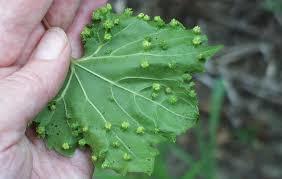
Features:
Grape Phylloxera (Daktulosphaira vitifoliae) is a tiny, aphid-like insect that poses a significant threat to grapevine pests and diseases. These pests are typically yellowish in color and measure less than 1/25 inch in length. Grape Phylloxera primarily affects the roots of grapevines, forming galls that disrupt the plant’s ability to absorb water and nutrients. The pest has a complex life cycle with both winged and wingless forms, enabling it to spread between plants and common vineyard disease. It is most notorious for its devastating impact on European grapevines (Vitis vinifera), which are particularly susceptible to root damage.
Symptoms:
Infestation by Grape Phylloxera can be identified by the presence of galls on the roots and sometimes on the leaves. Root galls appear as small, knobby swellings, while leaf galls are less common and manifest as small, green to yellowish blister-like formations on the undersides of leaves. Affected vines may exhibit stunted growth, yellowing leaves, reduced vigor, and ultimately, vine decline and death if the infestation is severe. The root damage impedes the plant’s ability to uptake water and nutrients, leading to overall poor health and reduced grape yield.
Management:
Managing Grape Phylloxera involves a combination of preventative, cultural, and chemical strategies. The most effective long-term solution is the use of resistant rootstocks. Grafting susceptible grape varieties onto Phylloxera-resistant rootstocks can significantly mitigate the impact of this pest. Regular monitoring of vineyards for early signs of infestation is crucial for timely intervention.
Chemical control options are limited, as soil-applied insecticides may not be fully effective against root-infesting Phylloxera and can impact the environment and non-target organisms. Biological control is still under research, but promoting healthy soil ecosystems can support beneficial organisms that may help suppress Phylloxera populations.
Cultural practices such as maintaining vineyard hygiene, avoiding the movement of infested soil or plant material, and ensuring proper irrigation and nutrition can enhance vine resilience. In heavily infested areas, replanting with resistant rootstocks may be necessary to establish a sustainable grapevine health. Implementing an integrated pest management (IPM) approach, which combines these strategies, can help manage Grape Phylloxera and protect grapevine pests and diseases health and productivity.
Solution:
Grape Phylloxera is a serious pest affecting vineyards, damaging grape roots and leaves. A promising solution to this issue is using Beveria WP, a wettable powder insecticide containing Beauveria bassiana. This naturally occurring fungus effectively targets and controls Grape Phylloxera by infecting and killing the pest. Applying Beveria WP can help protect grapevines without relying on harsh chemical grapevine diseases and treatments, promoting healthier crops and a more sustainable vineyard ecosystem.
Mealybugs (Pseudococcus spp.)
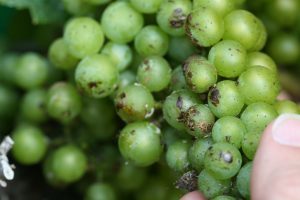
Features:
Mealybugs (Pseudococcus spp.) are small, soft-bodied insects that are a common pest in vineyards. They are easily recognized by their white, waxy coating, which gives them a cotton-like appearance. Mealybugs typically measure between 1/20 to 1/5 inch in length and are often found in clusters on vines. These pests feed on plant sap, preferring areas such as the undersides of leaves, stems, and grape clusters. They excrete a sticky substance known as honeydew, which can lead to the growth of sooty mold on the plant surfaces.
Symptoms:
Infestation by mealybugs can be identified by the presence of their white, waxy clusters on vines, leaves, and grape clusters. Symptoms include yellowing and wilting of leaves, stunted plant growth, and reduced vigor of the vines. The honeydew excreted by mealybugs can cause a black, sooty mold to develop on the leaves and fruit, interfering with photosynthesis and reducing the quality of the grapes. Severe infestations can lead to premature grape leaf disease and diminished grape yields.
Management:
Effective management of mealybugs involves a combination of monitoring, cultural practices, biological control, and chemical treatments. Regularly inspecting vineyards for early signs of mealybug presence is crucial for timely intervention. Sticky traps and pheromone traps can help monitor adult mealybug populations.
Cultural practices such as maintaining vineyard hygiene, removing and destroying infested plant material, and controlling ant populations (which protect mealybugs from natural predators) can help manage infestations. Additionally, ensuring proper irrigation and nutrition can enhance vine resilience.
Biological control can be achieved by encouraging the presence of natural predators and parasitoids, such as lady beetles, lacewings, and parasitic wasps, which feed on mealybugs. Introducing these beneficial insects into the vineyard can help reduce mealybug populations.
Chemical control may be necessary when mealybug populations exceed economic thresholds. Insecticides should be applied carefully to minimize the impact on beneficial insects and to avoid the development of resistance. Systemic insecticides can be effective, as they are absorbed by the plant and target the feeding mealybugs.
Implementing an integrated pest management (IPM) approach that combines these strategies can effectively control mealybug infestations and protect grapevine health and productivity.
Solution:
Mealybugs are a common pest in grape cultivation, causing significant damage to the vines by sucking plant sap and spreading diseases. A highly effective solution to treat Mealybugs is the use of Beveria WP, a wettable powder insecticide containing Beauveria bassiana. This biological insecticide works by infecting the pest with fungal spores, ultimately killing them and reducing their population. Beveria WP is environmentally friendly, targeting only the pests without harming beneficial insects or the plant itself. Regular application according to the manufacturer’s guidelines ensures a healthy and thriving grapevine, free from the destructive impact of Mealybugs.
Grape Leafhopper (Erythroneura spp.)
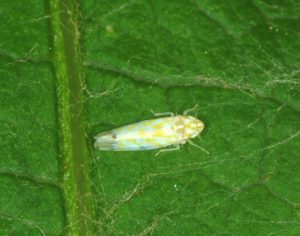
Features:
Grape Leafhopper (Erythroneura spp.) is a small, sap-feeding insect that is a common pest in vineyards. These insects are typically about 1/8 inch long, with a slender, wedge-shaped body. Grape Leafhoppers are characterized by their colorful markings, often with a combination of yellow, red, and white. They are most active during the growing season and feed on the undersides of grape leaves, using their piercing-sucking mouthparts to extract plant sap.
Symptoms:
Infestation by Grape Leafhoppers can be identified by the presence of white, stippled spots on the upper surfaces of leaves, a condition known as “hopperburn.” Over time, heavily infested leaves may turn yellow or brown and may prematurely fall off the vine. The loss of leaf area reduces the plant’s ability to photosynthesize, leading to reduced vigor and potentially lower grape yields. Additionally, the excrement of Grape Leafhoppers, known as honeydew, can encourage the growth of sooty mold on the leaves and fruit, further affecting plant health and grape quality.
Management:
The Grape Leafhoppers management involves a combination of monitoring, cultural practices, biological control, and chemical grapevine diseases and treatments. Regular scouting of vineyards for the presence of leafhoppers and their characteristic damage is essential for early detection and intervention. Yellow sticky traps can also be used to monitor adult leafhopper populations.
Cultural practices such as maintaining vineyard hygiene, including the removal of fallen leaves and weeds, can help reduce leafhopper breeding sites. Proper irrigation and fertilization can enhance vine health and resilience to leafhopper damage.
Biological control can be achieved by encouraging the presence of natural predators and parasitoids, such as spiders, predatory mites, and parasitic wasps, which feed on leafhoppers. Conserving these beneficial insects in the vineyard can help naturally reduce leafhopper populations.
Chemical control may be necessary when leafhopper populations exceed economic thresholds. Insecticides should be applied judiciously to minimize the impact on beneficial insects and to avoid the development of resistance. Selective insecticides that target leafhoppers while sparing beneficial insects can be particularly effective.
Implementing an integrated pest management (IPM) approach that combines these strategies can effectively manage Grape Leafhopper infestations and protect grapevine health and productivity. Regular monitoring and the integration of cultural, biological, and chemical controls are key to maintaining healthy vineyards.
Solution:
To treat Grape Leafhopper infestations in grapevines, Beveria WP, a product containing the entomopathogenic fungus Beauveria bassiana, offers an effective solution. This biological insecticide targets pests by infecting them with fungal spores, which penetrate the insect’s cuticle, proliferate inside, and ultimately lead to the pest’s death. To apply, mix the Beveria WP powder with water according to the recommended dosage, and spray it onto the grapevines, ensuring thorough coverage of leaves and stems where leafhoppers are present. This method provides a natural and eco-friendly way to manage grape leafhopper populations, reducing reliance on chemical pesticides and promoting sustainable grape cultivation.
Grape Root Borer (Vitacea polistiformis)
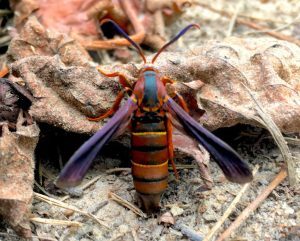
Features:
Grape Root Borer (Vitacea polistiformis) is a significant pest affecting grapevines, particularly in the eastern United States. The adult moths resemble wasps, with clear wings and a yellow and black striped abdomen, measuring about 1 inch in wingspan. The larvae, which cause the primary damage, are creamy white with a brown head and can grow up to 1 inch long. These larvae bore into the roots of grapevines, disrupting the plant’s ability to uptake water and nutrients.
Symptoms:
Infestation by Grape Root Borer can be difficult to detect early because the larvae feed underground. Symptoms include weakened vine growth, wilting during periods of stress, and reduced vigor. In severe cases, vines may die. Infested vines may show fewer leaves, smaller clusters, and reduced fruit quality and yield. The presence of larval tunnels filled with frass (insect excrement) in the roots can confirm infestation. Additionally, the emergence holes of adult moths at the base of the vine are indicative of the pest.
Management:
Managing Grape Root Borer involves a combination of monitoring, cultural practices, and control methods. Regular inspection of the base of vines for signs of adult emergence or frass can aid early detection. Pheromone traps can be used to monitor adult moth populations and help time control measures effectively.
Cultural practices such as hilling up soil around the base of the vines in late summer can help prevent larvae from reaching the roots. This technique involves mounding soil around the vine trunks to create a physical barrier that deters the larvae from boring into the roots.
Biological control can be supported by promoting the presence of natural enemies, such as entomopathogenic nematodes, which can parasitize and kill Grape Root Borer larvae. Applying these beneficial nematodes to the soil around the vines can help reduce larval populations.
Chemical control with insecticides may be necessary when borer populations are high. Soil-applied insecticides can target the larvae before they bore into the roots, but care should be taken to minimize environmental impact and avoid harming beneficial organisms. Insecticides should be used as part of an integrated pest management (IPM) approach, combining cultural, biological, and chemical methods to achieve effective control.
Implementing these strategies can help manage Grape Root Borer infestations and protect the health and productivity of grapevines.
Solution:
To effectively treat Grape Root Borer, two biological solutions are recommended: Beauveria bassiana and Bacillus thuringiensis (Bt), both available from Novobac. Beauveria bassiana is an entomopathogenic fungus that targets a variety of insect pests. Its spores attach to the insect’s cuticle, germinate, and penetrate the host’s body, causing death within 24 to 48 hours. This method is environmentally friendly and safe for non-target species, making it a preferred choice for sustainable agriculture. Bacillus thuringiensis (Bt), specifically the subspecies kurstaki (Btk), produces crystal proteins that disrupt the digestive system of targeted insects, causing them to stop feeding and die within a few days. Bt is highly specific to certain pests and safe for humans, animals, and beneficial insects. It is best applied early in the insect’s life cycle and can be integrated into pest management programs to reduce reliance on chemical pesticides. Both solutions provide effective and sustainable grapevine biological pest control, aligning with organic farming principles while ensuring the health and productivity of grapevines.
Spider Mites (Tetranychus spp.)
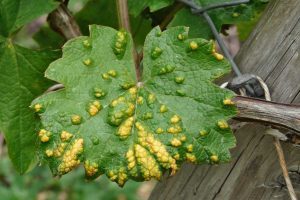
Features:
Spider mites (Tetranychus spp.) are tiny arachnids that can be serious pests in vineyards. They are typically less than 1/50 inch in length and can be red, green, yellow, or brown. Spider mites thrive in hot, dry conditions and can reproduce rapidly, leading to large populations in a short period. They feed on the undersides of grape leaves, piercing the plant cells to suck out the contents. This feeding behavior creates a characteristic stippling or speckling effect on the leaves. Spider mites also produce fine webbing, which can cover leaves and clusters.
Symptoms:
Symptoms of spider mite infestation include yellowing and bronzing of the leaves, stippling or speckling patterns, and premature leaf drop. Severely affected leaves may become dry and brittle. The presence of fine webbing on the leaves and grape clusters is a clear indication of spider mite activity. Infestations can reduce photosynthesis, leading to decreased vine vigor and reduced grape yield. In severe cases, defoliation can occur, which can significantly impact grape quality and production.
Management:
Managing spider mites requires a combination of monitoring, cultural practices, biological control, and chemical treatments. Regularly inspecting vineyards, particularly the undersides of leaves, for early signs of mite activity is crucial for effective control. Monitoring tools such as sticky cards can help detect the presence of spider mites.
Cultural practices to manage spider mites include maintaining adequate irrigation to reduce plant stress, avoiding excessive nitrogen fertilization (which can promote mite reproduction), and promoting good air circulation through proper canopy management. These practices create less favorable conditions for spider mite development.
Biological control involves encouraging natural predators such as predatory mites (Phytoseiulus persimilis, Neoseiulus californicus), lady beetles, and lacewings, which feed on spider mites. Introducing or conserving these beneficial insects can help keep spider mite populations in check.
Chemical control may be necessary when spider mite populations exceed economic thresholds. Miticides should be used judiciously to minimize the impact on beneficial insects and to prevent the development of resistance. It is essential to rotate miticides with different modes of action to reduce the risk of resistance buildup.
Implementing an integrated pest management (IPM) approach that combines these strategies can effectively control spider mite infestations and protect grapevine health and productivity.
Solution:
To effectively treat spider mites on grapevines, Novobac’s Beveria WP is a potent solution. This bioinsecticide utilizes Beauveria bassiana, a naturally occurring fungus, to control spider mites along with other pests such as whiteflies, thrips, and aphids. When applied, the fungal spores attach to the mites, penetrate their cuticles, and release toxic metabolites that kill the pests.
For optimal results, mix 0.5-1.0 grams of Beveria WP per liter of water for a foliar spray. Ensure thorough coverage of the leaves, focusing on the undersides where spider mites tend to reside. Repeat the application every 7-10 days until the infestation is under control. It’s important to avoid direct light and heat during application to protect the fungal spores.
Using Beveria WP provides a natural, eco-friendly method for controlling spider mites, reducing reliance on chemical pesticides, and supporting integrated pest management practices
Japanese Beetle (Popillia japonica)
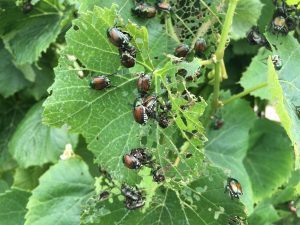
Features:
Japanese Beetle (Popillia japonica) is a highly destructive pest known for its broad host range, including grapevines. Adult Japanese Beetles are approximately 0.5 inches in length, with a distinctive metallic green body and copper-brown wing covers. They have white tufts of hair along the sides of their abdomen, which help in their identification. These beetles are notorious for their feeding habits, consuming foliage, flowers, and fruit, and they often skeletonize leaves, leaving behind only the veins.
Symptoms:
Infestation by Japanese Beetles can be identified by the characteristic skeletonized leaves, where the green tissue is eaten away, leaving a lace-like network of veins. The beetles can also damage grape clusters by feeding on the fruit, leading to scarring and increased susceptibility to secondary infections. The extensive defoliation caused by these pests reduces the plant’s photosynthetic capacity, which can lead to reduced vine vigor, stunted growth, and diminished grape yields.
Management:
Effective management of Japanese Beetles in vineyards requires a multi-faceted approach, combining monitoring, cultural practices, biological control, and chemical treatments. Regular scouting of vineyards during the beetle’s active period (mid-summer) is essential for early detection and timely intervention.
Cultural practices such as maintaining vineyard hygiene, removing and destroying infested plant material, and using row covers or netting to protect vines can help reduce beetle populations. Handpicking beetles from vines in the early morning, when they are less active, can also be an effective control measure for small-scale infestations.
Biological control involves encouraging natural predators and parasitoids that target Japanese Beetles. Tachinid flies and certain parasitic wasps are known to be effective biological control agents. Additionally, introducing nematodes or fungal pathogens into the soil can help control the larval stages of the beetles.
Chemical control may be necessary when beetle populations exceed economic thresholds. Insecticides should be used judiciously to minimize the impact on beneficial insects and prevent the development of resistance. Systemic and contact insecticides can be effective, but it is crucial to follow label instructions and application timing to achieve the best results.
Implementing an integrated pest management (IPM) approach that combines these strategies can effectively mitigate the impact of Japanese Beetles on grapevines, ensuring the health and productivity of the vineyard.
Solution:
To effectively manage Japanese beetle infestations in grape cultivation, using Myco Pestop, a product from Novobac, can be highly beneficial. Myco Pestop is a biological insecticide that utilizes the fungus Metarhizium anisopliae. This fungus infects and kills Japanese beetles by attaching to their outer shells, penetrating their exoskeletons, and ultimately causing their death. The fungus then produces spores that can spread to other beetles, thereby helping to control the population over time.
Myco Pestop offers several advantages over chemical pesticides. It is environmentally friendly, safe for beneficial insects and pollinators, and leaves no harmful residues, making it safe to use around humans and animals. For effective control, Myco Pestop can be applied through foliar spraying or soil treatment. It is recommended to apply the product early in the season and at regular intervals to manage beetle populations effectively.
By incorporating Myco Pestop into an integrated pest management strategy, grape growers can significantly reduce Japanese beetle damage and promote healthier crops. For more detailed information and application guidelines, you can visit the Novobac website.
Cutworms (Noctuidae family)
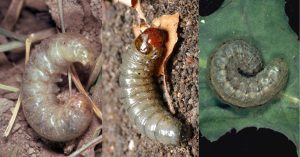
Features:
Cutworms (Noctuidae family) are a common pest in vineyards, known for their nocturnal feeding habits. These caterpillars are typically dark-colored, ranging from brown to black, and measure about 1 to 2 inches in length. Cutworms are the larval stage of several species of moths and are most active at night, hiding in the soil or under plant debris during the day. They are named for their habit of cutting down young plants at the base as they feed.
Symptoms:
Infestation by cutworms can be identified by the damage they cause to young grapevines. Symptoms include chewed leaves, stems, and buds, with young plants often being cut off at the soil level. This can result in significant damage to new growth and severely impact vine establishment and early development. In established vineyards, cutworm feeding can damage new shoots and buds, reducing vine vigor and potentially lowering grape yields.
Management:
Effective management of cutworms involves a combination of monitoring, cultural practices, biological control, and chemical treatments. Regularly inspecting vineyards, particularly during the early growing season, can help detect early signs of cutworm activity. Nighttime scouting with a flashlight can reveal feeding cutworms.
Cultural practices such as removing plant debris and weeds from the vineyard floor can reduce hiding places and overwintering sites for cutworms. Maintaining clean vineyard floors and using cover crops that are less attractive to cutworms can also help minimize infestations.
Biological control can be achieved by encouraging natural predators such as birds, ground beetles, and parasitic wasps, which feed on cutworms. Introducing or conserving these beneficial organisms can help keep cutworm populations in check.
Chemical control may be necessary when cutworm populations exceed economic thresholds. Insecticides should be applied carefully, targeting the soil surface and the base of the vines where cutworms are active. Bait formulations can be effective, as they attract and kill feeding cutworms.
Implementing an integrated pest management (IPM) approach that combines these strategies can effectively control cutworm infestations and protect grapevine health and productivity. Regular monitoring and timely intervention are key to preventing significant damage from cutworms in vineyards.
Solution:
Cutworms are a common pest in grape cultivation, known for their ability to damage young vines by cutting through stems at the soil level. A highly effective solution for treating cutworm infestations is the use of MET Zone from Novobac. This granular insecticide contains the spores of the fungus Metarhizium anisopliae, which naturally infects and kills cutworms along with other soil and surface pests like white grubs and root weevils.
The Metarhizium anisopliae fungus works by infecting the cutworms through their sense organs, where it germinates and consumes the insect from the inside out, eventually emerging to spread the spores further. This process makes MET Zone not only an effective treatment but also a preventive measure, establishing a natural barrier against future infestations.
To use MET Zone effectively, it should be applied to moist soil at the base of grapevines. Ensure the soil remains moist to facilitate the establishment and activity of the fungal spores. The granular formulation should be evenly distributed, ideally before or during planting, and the application can be repeated as necessary, especially after heavy rains or during peak pest seasons.
This organic and eco-friendly solution provides long-term protection without harming beneficial insects or leaving harmful residues in the soil, making it a sustainable choice for grape growers
Grape Leaffolder (Desmia funeralis)
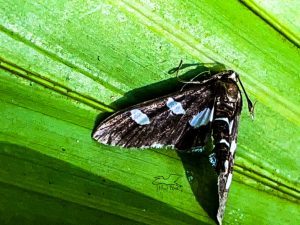
Features:
Grape Leaffolder (Desmia funeralis) is a notable pest in vineyards, recognized for its damage to grape foliage. The adult moth is small, with a wingspan of about 0.8 to 1.2 inches, and has dark brown to black forewings with distinctive white bands. The larvae are pale green with a black head, measuring approximately 0.6 inches long. Grape Leaffolders lay their eggs on grape leaves, and the larvae create shelters by folding and webbing leaves together, hence the name “leaffolder.”
Symptoms:
Infestation by Grape Leaffolder can be identified by the characteristic folded and webbed leaves. The larvae feed within these folded leaves, causing significant foliar damage. Symptoms include skeletonized leaves, reduced photosynthetic area, and general leaf desiccation. Severe infestations can lead to extensive defoliation, impacting vine vigor and grape yield. The presence of webbing and frass within the folded leaves is a clear indication of leaffolder activity.
Management:
Effective management of Grape Leaffolder involves regular monitoring, cultural practices, biological control, and, if necessary, chemical treatments. Scouting vineyards frequently during the growing season is essential for early detection. Inspecting leaves for folding and webbing can help identify infestations before they become severe.
Cultural practices, such as proper pruning and canopy management, can reduce leaffolder habitats and improve air circulation, making the environment less favorable for larval development. Removing and destroying infested leaves can help reduce the leaffolder population in the vineyard.
Biological control can be enhanced by encouraging natural predators and parasitoids, such as parasitic wasps, spiders, and predatory beetles, which prey on leaffolder larvae. Introducing these beneficial insects into the vineyard can help manage leaffolder populations naturally.
Chemical control may be necessary when leaffolder populations exceed economic thresholds. Insecticides should be applied carefully, targeting the larvae within the folded leaves. Bacillus thuringiensis (Bt), a biological insecticide, can be effective against young larvae while minimizing harm to beneficial insects.
Implementing an integrated pest management (IPM) approach that combines these strategies can effectively control Grape Leaffolder infestations and protect grapevine health and productivity.
Solution:
To effectively treat the Grape Leaffolder pest in grape cultivation, Bt Thuricide and Bacillus thuringiensis (Bt) from Novobac offer a reliable and environmentally friendly solution. Bt Thuricide, with the active ingredient Bacillus thuringiensis subspecies kurstaki (Btk), is a biological insecticide specifically designed to target caterpillar pests like the Grape Leaffolder. When the caterpillars ingest the Bt toxins, the proteins bind to receptors in their midgut, causing damage and leading to their death within a few days. This targeted action ensures that beneficial insects and other non-target organisms remain unharmed, making it suitable for integrated pest management programs.
For optimal results, apply Bt Thuricide at the first sign of newly hatched larvae, ensuring thorough coverage of the foliage. It can be reapplied as needed and is safe for use up to the day of harvest. This biopesticide is not only effective but also aligns with organic farming practices, offering a sustainable approach to pest control in grape cultivation
Western Grapeleaf Skeletonizer (Harrisina metallica)

Features:
Western Grapeleaf Skeletonizer (Harrisina metallica) is a significant pest of grapevines, recognizable by its metallic blue-black adult moths and distinctive yellow-striped larvae. The larvae, which measure about 0.5 to 0.75 inches in length, feed voraciously on grape leaves, leaving behind a “skeletonized” appearance as they consume the leaf tissue between the veins. Adult moths have a wingspan of approximately 1 inch and are active primarily at night.
Symptoms:
Infestation by Western Grapeleaf Skeletonizer can be identified by the characteristic skeletonized leaves, which appear lace-like due to the feeding activity of the larvae. Early signs include clusters of larvae feeding on the undersides of leaves. As the infestation progresses, leaves may turn brown and dry out, leading to defoliation. Severe defoliation can weaken the grapevine, reduce photosynthesis, and ultimately impact grape yield and quality. Additionally, the larvae’s excrement and shed skins can further contaminate the grape clusters.
Management:
Effective management of Western Grapeleaf Skeletonizer involves regular monitoring, cultural practices, biological control, and chemical treatments. Regularly scouting vineyards for the presence of larvae and skeletonized leaves can help in early detection and intervention.
Cultural practices such as proper pruning and canopy management can reduce overwintering sites and improve air circulation, making the environment less favorable for the pest. Removing and destroying infested leaves and clusters during the growing season can help reduce the pest population.
Biological control can be enhanced by encouraging natural predators and parasitoids, such as predatory beetles, spiders, and parasitic wasps, which can help suppress Western Grapeleaf Skeletonizer populations. Introducing these beneficial organisms into the vineyard can be an effective part of an integrated pest management strategy.
Chemical control with insecticides may be necessary when larval populations exceed economic thresholds. It is important to select insecticides that target the larvae while minimizing the impact on beneficial insects. Bacillus thuringiensis (Bt) and other bioinsecticides can be effective against young larvae and are less harmful to non-target organisms.
Implementing an integrated pest management (IPM) approach that combines these strategies can effectively control Western Grapeleaf Skeletonizer infestations, protecting grapevine health and productivity. Regular monitoring and timely interventions are key to managing this pest in vineyards.
Solution:
To address the Western Grapeleaf Skeletonizer pest in grape cultivation, Bacillus thuringiensis (Bt), specifically the subspecies kurstaki (Btk), offers an effective and environmentally friendly solution. This biological pesticide, available from Novobac, targets the larvae of moths and caterpillars by producing crystal proteins that disrupt the digestive systems of these pests, ultimately causing their death.
Bt is particularly effective against the Western Grapeleaf Skeletonizer because it specifically targets Lepidoptera larvae, the group to which this pest belongs. The application involves mixing the Bt powder with water and spraying it on the grapevine leaves where the larvae are feeding. It’s crucial to cover both the top and bottom surfaces of the leaves for maximum effectiveness.
One of the significant advantages of using Bt is its safety profile. It does not pose a risk to humans, animals, or beneficial insects, making it a preferred option for organic farming. Additionally, it is compatible with integrated pest management (IPM) programs, which aim to reduce reliance on chemical pesticides by using a combination of biological control methods.
For optimal results, it’s recommended to apply Bt in the early morning or evening when the air is calm and to target newly hatched larvae or at the first signs of egg-laying. Depending on the level of infestation, repeat applications may be necessary.
Using Bacillus thuringiensis from Novobac provides an effective, safe, and sustainable method to control the Western Grapeleaf Skeletonizer, helping to maintain healthy grape crops while minimizing environmental impact
Thrips (Frankliniella occidentalis)
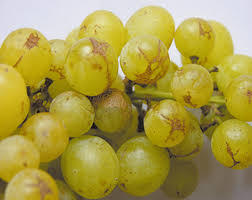
Features:
Thrips (Frankliniella occidentalis and other species) are tiny, slender insects that are significant pests in vineyards. These pests are typically less than 1/25 inch in length and can be difficult to see with the naked eye. Thrips are usually pale yellow to dark brown in color and have fringed wings. They feed on plant tissues by puncturing the surface and sucking out the cell contents, which can cause substantial damage to grapevines.
Symptoms:
Thrips infestation can be identified by several symptoms on grapevines. Early signs include silvery or bronze streaks on leaves due to their feeding activity. This damage may lead to distorted or scarred leaves and, in severe cases, premature leaf drop. On grape clusters, thrips can cause scarring and russeting on the fruit, leading to reduced quality and marketability of the grapes. Infested flower clusters may also exhibit poor fruit set, which can significantly impact yields.
Management:
Effective management of thrips in vineyards involves a combination of monitoring, cultural practices, biological control, and chemical treatments. Regular monitoring using sticky traps and visual inspections can help detect early thrips infestations. Inspecting flowers and leaves during the growing season is crucial for timely intervention.
Cultural practices that can reduce thrips populations include maintaining proper vineyard hygiene, such as removing weeds and debris that can serve as alternative hosts. Ensuring optimal irrigation and nutrition can enhance vine health and resilience to thrips damage.
Biological control can be enhanced by encouraging the presence of natural predators such as minute pirate bugs (Orius spp.), predatory mites, and lacewings, which feed on thrips. These beneficial insects can help keep thrips populations in check.
Chemical control may be necessary when thrips populations exceed economic thresholds. Insecticides should be applied carefully to target thrips while minimizing the impact on beneficial insects and avoiding resistance development. Rotating insecticides with different modes of action can help manage resistance.
Implementing an integrated pest management (IPM) approach that combines these strategies can effectively control thrips infestations and protect grapevine health and productivity. Regular monitoring and timely interventions are key to managing thrips in vineyards.
Solution:
To effectively treat thrips in grape cultivation, you can use Beveria WP from Novobac. Beveria WP is a bioinsecticide that leverages the naturally occurring fungus Beauveria bassiana. This fungus acts as a biological control agent by infecting and killing thrips and other pests such as whiteflies and aphids.
When applied, the spores of Beauveria bassiana attach to the insect’s cuticle, germinate, and penetrate the insect’s body. The growing fungus releases toxic metabolites that kill the pest, providing long-lasting control. This makes Beveria WP a highly effective and eco-friendly option for pest management, with up to 90% mortality rates for thrips.
To use Beveria WP, mix 0.5-1.0 grams per liter of water for foliar application or 2-3 grams per liter for soil application. Apply the solution every 7-10 days until the thrip population is under control. It’s important to mix the solution in a sealed container to ensure even concentration and avoid exposure to light or heat, which can reduce the efficacy of the spores.
Beveria WP is safe for humans and the environment, leaving no harmful residues, and can be integrated with other pest management practices. This makes it an ideal solution for sustainable agriculture and organic farming.
Grape Flea Beetle (Altica chalybea)
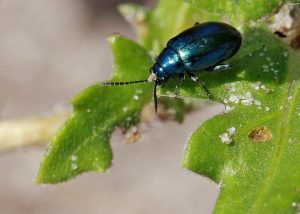
Features:
Grape Flea Beetle (Altica chalybea) is a small, metallic blue or green beetle that poses a significant threat to grapevines, especially during the early growing season. Adult beetles measure about 1/5 inch in length and are known for their strong jumping ability, similar to that of fleas, hence the name. The larvae are small, dark-colored, and feed on grape leaves. The beetles overwinter in leaf litter and emerge in the spring to feed on grapevine buds and leaves.
Symptoms:
Infestation by Grape Flea Beetles can be identified by the characteristic damage they cause. Early in the season, adult beetles chew on the swollen buds, hollowing them out before they can develop into shoots. This feeding can lead to significant loss of primary buds, which results in reduced grape yields. Later in the season, larvae and adult beetles feed on grape leaves, causing small, irregular holes or skeletonizing the foliage. This leaf damage can reduce photosynthesis, further impacting vine vigor and grape production.
Management:
Managing Grape Flea Beetle involves a combination of cultural practices, monitoring, and, if necessary, chemical control. Regularly inspecting vineyards, especially during early spring, helps in early detection of beetle activity. Monitoring can be enhanced by placing sticky traps around the vineyard to capture adult beetles.
Cultural practices such as removing leaf litter and other debris from around the base of the vines can reduce overwintering sites for the beetles. Ensuring healthy vine growth through proper irrigation, fertilization, and pruning can also help mitigate the impact of beetle feeding.
Chemical control may be required if beetle populations reach damaging levels. Applying insecticides early in the spring, when beetles are emerging and feeding on buds, can be effective in reducing their numbers. However, care should be taken to choose products that are specifically labeled for use on grapes and to follow all application guidelines to minimize environmental impact and avoid harming beneficial insects.
Implementing an integrated pest management (IPM) approach that combines regular monitoring, cultural controls, and judicious use of insecticides can effectively manage Grape Flea Beetle populations and protect grapevine health and productivity.
Solution:
To treat grape flea beetles effectively, Myco Pestop from Novobac is an excellent solution. This organic insecticide contains Metarhizium anisopliae, a naturally occurring fungus that infects and kills pests upon contact. The fungal spores germinate on the insect’s surface, penetrate its exoskeleton, and proliferate inside, ultimately leading to the beetle’s death within a few days. Myco Pestop is environmentally friendly, safe for humans and non-target species, and does not contribute to pesticide resistance. It can be applied as a foliar spray or soil treatment, making it versatile and easy to use. Regular applications at 5-10 day intervals ensure optimal control of flea beetle populations, promoting sustainable and organic grape cultivation
European Red Mite (Panonychus ulmi)
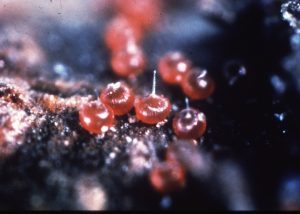
Features:
European Red Mite (Panonychus ulmi) is a tiny, red-colored arachnid pest that commonly affects grapevines. These mites are less than 1/50 inch in length and can be found on the undersides of leaves, where they spin fine webs. European Red Mites have multiple generations per year, which can lead to rapid population increases under favorable conditions. Their feeding habits can cause significant damage to grapevines, affecting both vine health and grape quality.
Symptoms:
Infestation by European Red Mites is characterized by a range of symptoms. The mites feed by piercing leaf cells and sucking out the contents, leading to a stippled or bronzed appearance on the leaves. This damage can reduce the plant’s photosynthetic capability, resulting in reduced vigor and growth. Heavily infested leaves may turn yellow, dry out, and eventually fall off. Severe infestations can lead to reduced fruit size and quality, impacting overall yield.
Management:
Effective management of European Red Mite involves regular monitoring and an integrated approach that includes cultural, biological, and chemical controls. Monitoring should include regular inspections of the undersides of leaves for mites and their webbing. Use of a magnifying lens can aid in detecting these small pests early.
Cultural practices such as maintaining proper irrigation and fertilization can help reduce vine stress and improve resilience against mite infestations. Avoiding excessive nitrogen fertilization is particularly important, as it can promote mite population growth.
Biological control can be enhanced by conserving and encouraging the presence of natural predators, such as predatory mites (Phytoseiidae family), lady beetles, and lacewings, which feed on European Red Mites. Introducing these beneficial insects into the vineyard can help keep mite populations in check.
Chemical control may be necessary when mite populations exceed economic thresholds. Miticides should be applied judiciously, rotating different modes of action to prevent resistance development. It is important to follow label instructions carefully and consider the impact on non-target organisms, including beneficial insects.
Implementing an integrated pest management (IPM) strategy that combines these practices can effectively manage European Red Mite infestations, maintaining vine health and productivity. Regular monitoring, timely interventions, and a balanced approach to control methods are key to successful management.
Solution:
To treat the European Red Mite pest on grapevines, Novobac’s Beveria WP is an effective solution. This bioinsecticide is based on the naturally occurring fungus Beauveria bassiana, which targets and controls a range of insect pests, including mites. The spores of the fungus attach to the pest, germinate, and eventually kill the insect through toxic metabolites. For optimal results, apply Beveria WP as a foliar spray or soil drench every 7-10 days. This eco-friendly product is safe for both the environment and humans
Grapes Plant diseases
Powdery Mildew (Grape Leaf Diseases)
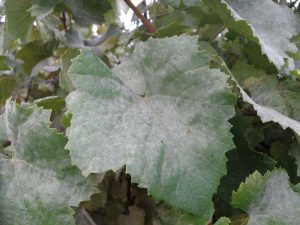
Powdery Mildew of grapes (Erysiphe necator) is a common and serious fungal disease affecting grapevines. It is characterized by a white to gray powdery growth on the surfaces of leaves, shoots, and grape clusters. The fungus thrives in warm, dry conditions and can spread rapidly, significantly impacting vine health and grape quality. Unlike many other fungal diseases, Powdery Mildew of grapes does not require free moisture for infection, making it particularly challenging to manage.
Symptoms:
Symptoms of Powdery Mildew infestation include the appearance of white, powdery spots on leaves, stems, and fruit. Infected leaves may become distorted and can exhibit a mottled appearance as the disease progresses. Shoots may become stunted and exhibit a white, powdery coating. On grape clusters, Powdery Mildew can cause berries to crack and split, leading to secondary infections and reducing the overall quality and marketability of the fruit. Severe infestations can lead to reduced photosynthesis, vine vigor, and yield.
Management:
Effective management of Powdery Mildew requires an integrated approach, combining cultural, chemical, and biological control methods. Regular monitoring is crucial to detect early signs of the disease and implement timely interventions.
Cultural practices that can help manage Powdery Mildew include proper canopy management to ensure good air circulation and light penetration, reducing the humidity levels that favor the fungus. Removing infected plant material and ensuring proper pruning can also help reduce the sources of infection.
Chemical control is a critical component of Powdery Mildew management. Fungicides should be applied preventively, especially during periods of high risk. It is important to rotate fungicides with different modes of action to prevent resistance development. Common fungicides used for Powdery Mildew include sulfur, potassium bicarbonate, and various systemic fungicides.
Biological control options include the use of beneficial microbes that can suppress the growth of Powdery Mildew. These biocontrol agents can be applied as part of an integrated pest management (IPM) program.
In addition to these strategies, choosing resistant grape varieties can significantly reduce the impact of Powdery Mildew. Implementing an IPM approach that combines these cultural, chemical, and biological methods can effectively manage Powdery Mildew, protecting vine health and grape quality. Regular monitoring, timely application of fungicides, and good vineyard hygiene are key to successful disease management.
Solution:
Powdery mildew is a common fungal disease affecting grapevines, characterized by white, powdery spots on leaves and stems, which can lead to reduced photosynthesis, weakened plants, and decreased yields. A highly effective solution for treating this disease is Trianum-V from Novobac. Trianum-V is a natural fungicide that utilizes the beneficial fungus Trichoderma harzianum to combat powdery mildew.
Trianum-V works by outcompeting harmful fungi for space and nutrients, thereby inhibiting their growth. It also produces enzymes that break down the cell walls of pathogenic fungi, enhancing plant defense mechanisms through induced systemic resistance (ISR). This process not only helps in controlling the current infection but also strengthens the plant against future fungal attacks.
To use Trianum-V effectively, apply it as a foliar spray at a rate of 2-3 grams per liter of water, ensuring thorough coverage of the plant, especially the undersides of the leaves. It’s best applied preventively or at the first sign of disease, with subsequent applications every 7-14 days depending on the severity of the infection. For optimal results, incorporating Trianum-V into a rotational program with other fungicides is recommended.
Trianum-V offers numerous benefits including increased yield, improved plant stress resilience, and suitability for organic farming due to its residue-free formulation
Downy Mildew (Plasmopara viticola)
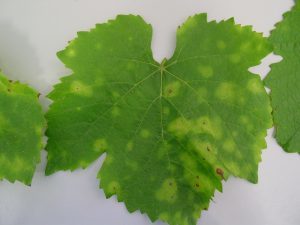
Features:
Downy Mildew (Plasmopara viticola) is a highly destructive fungal disease that affects grapevines. It thrives in warm, humid conditions and can rapidly spread throughout a vineyard if not managed properly. The pathogen primarily targets leaves but can also infect stems, flowers, and fruit. Downy Mildew is recognized by the presence of yellowish-green lesions on the upper surface of leaves and white, downy sporulation on the undersides.
Symptoms:
Early symptoms of Downy Mildew include yellow, oily spots on the upper leaf surface, often referred to as “oil spots.” As the disease progresses, these spots turn brown and necrotic. On the underside of the leaves, a white, downy growth appears, especially under humid conditions. Infected shoots and tendrils may become distorted and develop similar downy growths. If flowers and young fruit are infected, they can shrivel and drop prematurely. Severe infestations can lead to extensive defoliation, reducing the plant’s ability to photosynthesize and compromising overall vine health and yield.
Management:
Managing Downy Mildew requires a comprehensive approach that includes cultural practices, monitoring, and chemical controls. Regular monitoring of the vineyard, particularly during periods of wet, humid weather, is crucial for early detection and management.
Cultural practices such as proper pruning and canopy management can improve air circulation and reduce humidity within the vineyard, making conditions less favorable for the disease. Avoiding overhead irrigation can also help reduce leaf wetness and the risk of Downy Mildew development.
Chemical control involves the use of fungicides, which are most effective when applied preventatively or at the first sign of disease. Fungicides with different modes of action should be rotated to prevent resistance development. Commonly used fungicides include copper-based products, systemic fungicides, and protectant fungicides. It’s important to follow label instructions and application guidelines to maximize effectiveness and minimize environmental impact.
Implementing an integrated pest management (IPM) approach that combines these strategies can effectively control Downy Mildew in grapevines. Regular monitoring, timely fungicide applications, and cultural practices that reduce humidity and leaf wetness are key components of a successful Downy Mildew management program.
Solution:
To combat Downy Mildew in grapes, Trianum-V from Novobac offers an effective organic solution. Trianum-V utilizes Trichoderma harzianum, a beneficial fungus that outcompetes harmful pathogens and stimulates the plant’s own defense mechanisms. This biocontrol agent enhances systemic acquired resistance (SAR) and induced systemic resistance (ISR) in plants, making them more resilient against infections. For optimal results, apply Trianum-V as a foliar spray, ensuring thorough coverage, particularly on the undersides of leaves where the mildew is most prevalent. This product is suitable for organic farming and promotes healthy soil and plant conditions without harming beneficial organisms
Botrytis Bunch Rot (Botrytis cinerea)
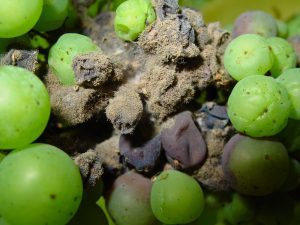
Features:
Botrytis Bunch Rot, also known as Gray Mold, is caused by the fungal pathogen Botrytis cinerea. This disease is a significant threat to grapevines, particularly in regions with humid or wet weather conditions. Botrytis Bunch Rot primarily affects grape clusters but can also infect leaves, stems, and flowers. The fungus thrives in cool, moist environments and can remain dormant in plant debris until favorable conditions arise.
Symptoms:
Symptoms of Botrytis Bunch Rot begin with the appearance of water-soaked spots on grape berries. These spots quickly enlarge and become covered with grayish-brown fungal mycelium and spores. Infected berries may shrivel, split, and eventually drop off. The disease often starts in the interior of the grape cluster, making early detection difficult. Under humid conditions, the gray mold can spread rapidly, causing entire clusters to rot. Additionally, infected clusters may develop a sour smell due to secondary bacterial infections.
Management:
Effective management of Botrytis Bunch Rot involves a combination of cultural practices, biological controls, and chemical grapevine diseases and treatments. Regular vineyard monitoring is essential to detect early signs of the disease and implement timely interventions.
Cultural practices include:
- Canopy Management: Pruning and training vines to improve air circulation and sunlight penetration can help reduce humidity levels around grape clusters, making conditions less favorable for Botrytis development.
- Sanitation: Removing and destroying infected plant debris, fallen leaves, and rotting berries can reduce the source of fungal spores.
- Water Management: Avoiding overhead irrigation and ensuring proper drainage can help minimize excess moisture in the vineyard.
Biological control options involve encouraging the presence of natural antagonists, such as Trichoderma spp. and Bacillus subtilis, which can inhibit Botrytis growth and infection.
Chemical control may be necessary in regions prone to Botrytis outbreaks. Fungicide applications should be timed carefully, especially during periods of high humidity or rainfall. Fungicides with different modes of action should be rotated to prevent resistance development. Pre-bloom, bloom, and pre-harvest are critical periods for fungicide applications to protect grape clusters from infection.
Implementing an integrated pest management (IPM) strategy that combines these approaches can effectively control Botrytis Bunch Rot. Regular monitoring, proper vineyard hygiene, and a balanced approach to cultural, biological, and chemical controls are key to minimizing the impact of this disease on grape production.
Solution:
Trianum-V from Novobac is an effective solution for treating Botrytis Bunch Rot in grapes. It is a natural fungicide containing the beneficial fungus Trichoderma harzianum. This fungus helps control harmful pathogens by competing for space and nutrients, effectively colonizing plant surfaces before the pathogens can establish themselves. Trianum-V works by producing enzymes that break down the cell walls of the fungi causing the disease, enhancing the plant’s natural defense mechanisms through systemic acquired resistance (SAR) and induced systemic resistance (ISR). This approach not only prevents and controls molds, rots, and blights but also improves plant resilience and yield without leaving harmful residues, making it suitable for organic production
Black Rot (Guignardia bidwellii)

Features:
Black Rot (Guignardia bidwellii) is a fungal disease that significantly impacts grapevines, causing damage to leaves, shoots, and fruit. The fungus thrives in warm, humid conditions and can spread rapidly under these circumstances. Black Rot overwinters in mummified berries and infected plant debris, producing spores that infect new growth in the spring.
Symptoms:
Black Rot manifests through several key symptoms. Initial signs on leaves appear as small, circular, reddish-brown spots with dark borders. These spots can enlarge, creating a “bullseye” pattern. Infected shoots exhibit dark lesions that can girdle and kill the young tissue. The most destructive phase is the infection of grape berries, which show small, black spots that expand and cause the fruit to shrivel and mummify. The mummified berries often remain attached to the cluster, serving as a source of spores for future infections.
Management:
Effective management of Black Rot involves a combination of cultural practices, chemical treatments, and regular monitoring. Implementing these strategies helps reduce the disease’s spread and impact on grapevines.
Cultural practices are crucial in managing Black Rot. Removing and destroying mummified berries and infected plant debris from the vineyard reduces the source of fungal spores. Proper pruning to enhance air circulation and sunlight penetration within the canopy can also reduce humidity levels, making conditions less favorable for fungal growth. Additionally, choosing grapevine varieties that are less susceptible to Black Rot can be a proactive measure.
Chemical control is often necessary to manage Black Rot, particularly in regions prone to warm, humid weather. Fungicides should be applied preventatively, starting at bud break and continuing through the growing season, especially during wet periods. Rotating fungicides with different modes of action helps prevent the development of resistant fungal strains. It’s essential to follow label instructions carefully for effective and safe application.
Regular monitoring and early detection are vital for controlling Black Rot. Scouting vineyards frequently during the growing season for early signs of infection allows for timely intervention. Prompt removal of infected tissue can help contain the spread of the fungus.
Integrating these management practices—cultural, chemical, and monitoring—forms an effective strategy to combat Black Rot. By maintaining vigilance and employing a holistic approach, vineyard managers can protect grapevines from this destructive disease, ensuring healthy growth and productive yields.
Solution:
To treat Black grape Rot disease in grapes, Trianum Shield, a biological fungicide containing Trichoderma harzianum from Novobac, offers an effective solution. Trianum Shield is a biofungicide that targets soil-borne pathogens, including those responsible for Black Rot. The active ingredient, Trichoderma harzianum, colonizes plant roots, creating a protective barrier against harmful fungi. This fungus outcompetes pathogens for space and nutrients, producing enzymes that degrade their cell walls and inhibit their growth.
Applying Trianum Shield not only protects grape vines from Black Rot but also promotes healthier root systems and improved nutrient uptake, leading to stronger plants overall. For best results, apply the biofungicide early in the growing season and reapply every 10-12 weeks to maintain root protection throughout the season. This treatment is suitable for organic production, as it leaves no harmful residues and enhances the plant’s natural defense mechanisms
Anthracnose (Elsinoe ampelina)
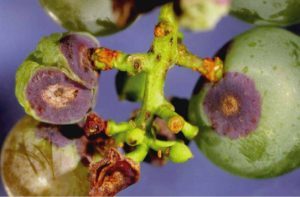
Features:
Anthracnose (Elsinoe ampelina) is a fungal disease that affects grapevines, particularly in warm and humid climates. This disease is known for causing significant damage to leaves, shoots, and fruit. The fungus overwinters in infected plant debris and becomes active in the spring, spreading through splashing rain or irrigation water. It can cause lesions on various parts of the plant, leading to reduced vine vigor and yield.
Symptoms:
The symptoms of Anthracnose can be observed on leaves, shoots, and fruit. On leaves, the disease causes small, circular, sunken lesions that start as dark, water-soaked spots and eventually turn gray or tan with dark borders. Severe infections can cause leaf distortion and defoliation. On shoots, Anthracnose creates elongated, sunken lesions that can girdle and kill young shoots. These lesions are often dark brown to black and may crack, giving the shoots a scabby appearance. On fruit, the disease causes round, sunken lesions with dark margins, leading to berry cracking and rot. The infected fruit becomes unmarketable, reducing overall yield.
Management:
Effective management of Anthracnose requires an integrated approach that includes cultural, chemical, and biological strategies.
Cultural practices involve maintaining good vineyard hygiene by removing and destroying infected plant debris and pruning out diseased shoots. This helps reduce the sources of fungal spores. Ensuring good air circulation through proper vine training and spacing can also help reduce humidity levels, making conditions less favorable for fungal growth.
Chemical control involves the use of fungicides, which can be effective when applied preventatively or at the first sign of disease. Fungicides such as those containing copper, sulfur, or synthetic chemicals like strobilurins and sterol inhibitors can be used. It is important to rotate fungicides with different modes of action to prevent resistance development and follow label instructions for application rates and timing.
Biological control can be enhanced by encouraging the presence of beneficial organisms that can suppress the fungal pathogen. This includes the use of biological fungicides containing beneficial bacteria or fungi that can outcompete or inhibit the growth of Elsinoe ampelina.
Implementing an integrated pest management (IPM) approach that combines these strategies can effectively manage Anthracnose in grapevines. Regular monitoring, timely interventions, and maintaining overall vine health are crucial for minimizing the impact of this disease on grape production.
Solution:
To treat Anthracnose in grapes, Trianum Shield from Novobac offers an effective solution. This biofungicide contains Trichoderma harzianum, a beneficial fungus that protects plants by colonizing the root system and creating a protective barrier against pathogens. Trianum Shield works through various modes of action, such as outcompeting harmful fungi for space and nutrients, enhancing the plant’s immune response, and stimulating root development. This not only controls the disease but also promotes overall plant health and increased yields. For optimal results, Trianum Shield should be applied early in the growing season and can be reapplied every 10-12 weeks to maintain protection throughout the season
Phomopsis Cane and Leaf Spot (Phomopsis viticola)
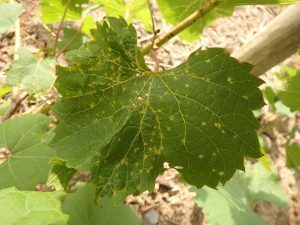
Features:
Phomopsis Cane and Leaf Spot (Phomopsis viticola) is a fungal disease that primarily affects grapevines, targeting canes, leaves, and fruit. This disease is recognized by the presence of small, dark lesions on the canes, which often develop into elongated, sunken, and blackened areas. On leaves, the fungus causes small, dark spots with yellow halos, which can merge to form larger necrotic areas. Infected fruit may exhibit small, dark lesions, leading to fruit rot. The disease thrives in wet and humid conditions, with the spores being spread by rain splash and wind.
Symptoms:
Symptoms of Phomopsis Cane and Leaf Spot include dark, sunken lesions on young canes, which can weaken the vines and predispose them to other infections. Leaf symptoms begin as small, dark spots with yellow margins that eventually coalesce, causing significant leaf damage and defoliation in severe cases. On fruit, the disease manifests as small, black spots that can lead to fruit rot, impacting grape quality and yield. Infected canes may also crack and split, further compromising vine health and productivity.
Management:
Effective management of Phomopsis Cane and Leaf Spot involves a combination of cultural practices, fungicide applications, and careful monitoring. Cultural practices such as proper pruning to remove and destroy infected canes and maintaining good air circulation through canopy management can reduce disease incidence. It is also important to avoid overhead irrigation, which can create favorable conditions for the fungus.
Fungicide applications are critical, particularly during the early growing season when shoots are emerging and are most susceptible. Fungicides should be applied according to label recommendations and rotated to prevent resistance development. Monitoring vineyards regularly for early signs of the disease can help in timely application of control measures.
Additionally, selecting resistant grapevine varieties and ensuring overall vine health through proper nutrition and irrigation can enhance the plant’s ability to withstand infections. Implementing an integrated pest management (IPM) approach that combines these strategies can effectively manage Phomopsis Cane and Leaf Spot, ensuring healthy vines and high-quality grape production. Regular monitoring, cultural practices, and judicious use of fungicides are essential components of a successful management plan.
Solution:
To treat Phomopsis Cane and Leaf Spot in grapes, the use of biological control agents such as Trichoderma harzianum and Bacillus subtilis from Novobac can be highly effective. Trichoderma harzianum acts by colonizing the root zone and outcompeting pathogenic fungi, enhancing plant health through improved root development and systemic resistance against pathogens. Bacillus subtilis, on the other hand, produces antibiotics and enzymes that inhibit fungal growth and bolster the plant’s immune response, providing an additional layer of protection. Incorporating these biological solutions into an integrated pest management strategy helps control Phomopsis effectively while promoting sustainable and healthy grape cultivation practices.
Esca (Complex of fungi including Phaeoacremonium and Phaeomoniella spp.)
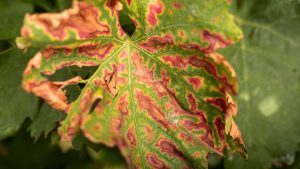
Features:
Esca, also known as “black measles” or “Spanish measles,” is a complex grapevine disease caused by a consortium of fungi, including Phaeoacremonium aleophilum, Phaeomoniella chlamydospora, and various species of Fomitiporia. This disease primarily affects the wood of grapevines, leading to a decline in vine health and productivity. Esca can infect vines of all ages, but it is more commonly observed in mature vineyards. The fungi invade the vascular system of the vine, causing wood decay, which can lead to the eventual death of the plant.
Symptoms:
The symptoms of Esca vary depending on the stage and severity of the infection. In the early stages, infected vines may show “tiger stripes” on leaves, characterized by interveinal chlorosis and necrosis. These symptoms typically appear in mid to late summer. As the disease progresses, dark brown to black streaks or spots can be observed on the vine’s wood, often accompanied by white rot in the trunk and arms. Berries on affected vines may shrivel and display black spotting, known as “black measles.” In severe cases, vines may suddenly collapse and die, especially under stress conditions like drought or excessive heat.
Management:
Managing Esca is challenging due to its complex nature and the lack of highly effective chemical treatments. The primary strategy for managing Esca involves cultural practices aimed at reducing infection and spread. Regular monitoring of vineyards for early symptoms is crucial. Removing and destroying infected plant material, including pruning out diseased wood and removing infected vines, can help limit the spread of the disease. It is also essential to disinfect pruning tools to prevent cross-contamination.
Promoting vine health through proper irrigation, fertilization, and canopy management can improve the vine’s resistance to Esca. Avoiding excessive vine stress, such as water deficits or excessive heat, can help mitigate the impact of the disease. In some cases, the application of fungicides during pruning wounds may provide some protection, but their effectiveness is limited and should be used as part of an integrated management approach.
Biological control options are being researched, but currently, there are no widely adopted biological treatments for Esca. Implementing an integrated pest management (IPM) strategy that includes regular monitoring, cultural practices, and maintaining overall vine health is the best approach to managing this complex and destructive disease.
Solution:
To treat Esca grape disease, utilizing biological solutions such as Trichoderma harzianum and Bacillus subtilis can be highly effective. Trichoderma harzianum works as a beneficial fungus that colonizes the root zone, outcompeting pathogenic fungi and enhancing plant health by inducing systemic resistance. This fungus creates a protective barrier, reducing the impact of harmful pathogens on grapevines. It promotes root development and improves soil structure, making plants more resilient to diseases like Esca.
Bacillus subtilis acts as a biological fungicide by producing antifungal compounds that suppress the growth of pathogenic fungi. It enhances the plant’s natural defense mechanisms, providing an additional layer of protection against diseases. Regular application of Bacillus subtilis can significantly reduce disease severity and improve overall crop health, ensuring healthier grapevines and better yields.
Both Trichoderma harzianum and Bacillus subtilis, available from Novobac, offer sustainable and eco-friendly solutions for managing Esca disease in grape cultivation. By integrating these biological agents into a comprehensive disease management strategy, grape growers can effectively control Esca and maintain the health and productivity of their vineyards.
Armillaria Root Rot (Armillaria spp.)
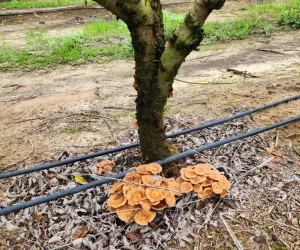
Features:
Armillaria Root Rot, caused by fungi in the genus Armillaria, is a serious disease that affects grapevines by attacking their root systems. These fungi can persist in the soil for many years, infecting a wide range of plants. White, fan-like mycelial growths appear under the bark at the base of the vine, along with black, shoestring-like structures called rhizomorphs, characterizing the disease. Armillaria Root Rot poses the most problems in vineyards established on sites previously occupied by infected woody plants.
Symptoms:
Symptoms of Armillaria Root Rot in grapevines include a gradual decline in vigor, yellowing of leaves, and reduced shoot growth. As the disease progresses, vines may exhibit premature leaf drop, dieback of shoots, and eventual vine death. Affected vines often have a sparse canopy and reduced fruit yield. Cutting into the bark near the base of the vine can reveal the characteristic white mycelial fans, confirming the presence of the fungus.
Management:
Managing Armillaria Root Rot requires a combination of cultural practices and preventive measures, as there are no effective chemical controls for this disease. Selecting vineyard sites with no history of Armillaria infection is the best preventive strategy. In existing vineyards, removing and destroying infected vines and as much of the root system as possible can help reduce the spread of the disease. Improving soil drainage and avoiding excessive irrigation can create less favorable conditions for the fungus.
Maintaining vine health through proper nutrition and irrigation management is essential, as healthy vines are better able to resist infections. Planting on rootstocks that are less susceptible to Armillaria can also help mitigate the impact of the disease. In some cases, physical barriers, such as trenching around infected areas, can limit the spread of rhizomorphs to healthy vines. Regular monitoring of vineyards for early signs of Armillaria infection is crucial for timely intervention and management.
Implementing an integrated approach that combines these strategies can effectively manage Armillaria Root Rot in grapevines. While the disease can be challenging to control, vigilant monitoring and proactive management practices can help maintain vine health and productivity in affected vineyards.
Solution:
To treat Armillaria Root Rot in grapevines, a biological solution involves using Trichoderma harzianum and Trichoderma viride, as offered by Novobac. These beneficial fungi work effectively by outcompeting the harmful pathogens responsible for the disease. Trichoderma harzianum enhances soil health and stimulates plant growth by producing enzymes that degrade the cell walls of pathogenic fungi, thereby preventing their proliferation. Additionally, it boosts the plant’s immune system, making the grapevines more resistant to diseases.
Trichoderma viride operates similarly, producing various enzymes like chitinase and glucanase, which break down the cell walls of harmful fungi. This fungus also promotes better nutrient uptake and enhances root development, contributing to overall plant health and stress resistance.
Using these Trichoderma species from Novobac can reduce the need for chemical fungicides, offering a sustainable and eco-friendly alternative to managing Armillaria Root Rot in grape cultivation
Fusarium Wilt (Fusarium oxysporum)
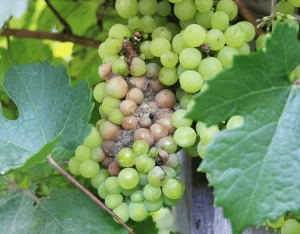
Features:
Fusarium Wilt, caused by the soil-borne fungus Fusarium oxysporum, is a destructive disease that affects grapevines. This pathogen primarily invades the plant through the roots and colonizes the vascular system, leading to a blockage of water and nutrient transport. The fungus can persist in the soil for many years, making management challenging. Fusarium Wilt is characterized by its ability to cause significant damage to both young and mature vines, impacting grapevine health and productivity.
Symptoms:
The symptoms of Fusarium Wilt in grapevines begin with a general decline in vine vigor. Infected plants exhibit yellowing and wilting of leaves, starting from the base and progressing upwards. Leaves may also show a scorched appearance along the margins and between veins. As the disease advances, the vine’s growth becomes stunted, and the plant may eventually die. One of the distinctive signs of Fusarium Wilt is the browning or blackening of the vascular tissue when the stem is cut open, indicating internal infection. Additionally, the roots may become discolored and decayed, further hindering the plant’s ability to uptake water and nutrients.
Management:
Managing Fusarium Wilt in grapevines involves a combination of cultural practices, biological control, and chemical treatments. Cultural practices include selecting and planting resistant grapevine varieties and using certified disease-free rootstocks. Proper vineyard hygiene, such as removing and destroying infected plant material, can help reduce the spread of the pathogen. Crop rotation with non-host plants can also minimize the buildup of Fusarium oxysporum in the soil.
Biological control methods focus on enhancing soil health and promoting beneficial microorganisms that can suppress the Fusarium fungus. The use of organic amendments, such as compost, can improve soil structure and microbial diversity, creating an unfavorable environment for the pathogen. Additionally, the introduction of specific biocontrol agents, such as Trichoderma spp., can help inhibit the growth of Fusarium oxysporum.
Chemical control options are limited for Fusarium Wilt, as soil fumigants and fungicides may not be entirely effective against the soil-borne nature of the pathogen. However, soil treatments with fungicides can be used as a preventive measure in nurseries and new plantings. It is crucial to apply these treatments according to label instructions and in conjunction with other integrated management strategies to maximize their efficacy.
Implementing an integrated pest management (IPM) approach that combines these practices is essential for effectively managing Fusarium Wilt in grapevines. Regular monitoring, early detection, and the integration of multiple control methods can help mitigate the impact of this disease and ensure the long-term health and productivity of vineyards.
Solution:
To treat Fusarium Wilt in grapevines, Trianum Shield from Novobac offers an effective organic solution. Trianum Shield is a biofungicide with Trichoderma harzianum as its active ingredient, which helps combat soil-borne pathogens such as Fusarium. When applied early in the plantation stage, Trianum Shield rapidly colonizes the rhizosphere, forming a protective biofilm around the roots. This action not only reduces the damage to plant roots through nutrient competition but also improves soil structure, promotes stronger root development, and enhances nutrient uptake. By doing so, it effectively suppresses the Fusarium wilt pathogen and boosts the plant’s overall health, leading to increased potential yields and reduced crop losses
Nutrition and Soil Treatment on Grape
Effective Nutrient Management
To achieve healthy and productive grapevines, nutrient management plays a crucial role. Organic grape cultivation depends on nutrient-rich, well-maintained soil, achieved through organic fertilizers, compost, and cover crops. Regular applications of compost supply essential nutrients like nitrogen, phosphorus, and potassium, enhancing soil structure and water retention.
Enhancing Soil Fertility
Incorporating green manures and cover crops, such as clover or legumes, can boost soil fertility by fixing nitrogen and adding organic matter. Additionally, rotating crops and practicing intercropping can prevent nutrient depletion and minimize pest and disease pressures. By prioritizing soil health and sustainable practices, grape growers can ensure balanced nutrition, leading to vigorous plant growth and superior quality produce.
Utilizing Beneficial Products
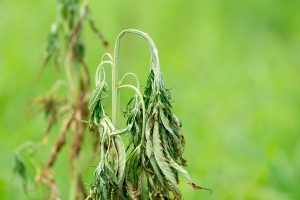
Products like Soil Vigor from Novobac play a significant role in breaking down organic matter and releasing trapped nutrients, enhancing soil fertility. Soil Vigor introduces beneficial microorganisms that foster a symbiotic relationship with plant roots, improving nutrient uptake and resilience against diseases. These microorganisms, including bacteria, fungi, and archaea, decompose organic matter, releasing essential nutrients back into the soil, making them readily available for plants. They also improve soil structure, enhance water retention, and stimulate root growth through the production of growth-promoting substances. This biological approach boosts plant vigor and productivity while promoting sustainable farming practices by reducing the need for chemical fertilizers and pesticides.
Phosphorus Management
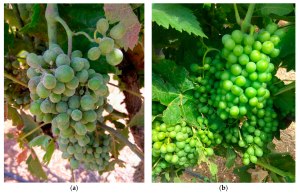
Cropium aids in phosphorus solubilization, making phosphorus more available to plants. This innovative solution enhances crop growth by promoting the absorption of inorganic phosphorus from the soil, crucial for energy transfer, photosynthesis, and nucleic acid synthesis. By facilitating phosphorus uptake, Cropium ensures adequate nutrient supply, boosting crop yield and quality, and supporting sustainable farming practices.
Nitrogen Management
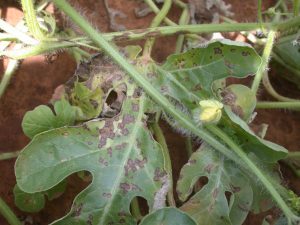
Metilo, another innovative solution, promotes nitrogen fixation by converting atmospheric nitrogen into forms usable by plants. This process helps crops efficiently acquire necessary nitrogen, leading to improved health and productivity. Metilo supports robust plant development and contributes to sustainable farming by reducing reliance on synthetic nitrogen fertilizers, increasing crop yields, and fostering environmentally friendly agricultural practices.
Common Challenges in Implementing Grapevine Pest and Disease Management
Implementing effective pest and disease management strategies in grape cultivation can be challenging due to several factors:
- Resistance Development: Pests and diseases can develop resistance to control measures over time, necessitating constant monitoring and adaptation of strategies.
- Environmental Factors: Weather conditions, such as humidity and temperature fluctuations, can influence pest and disease prevalence, making management unpredictable.
- Complexity of Ecosystems: Grapevine ecosystems are composed of various organisms that are interrelated in various ways; hence, it is difficult to combat pests and diseases without side effecting the beneficial organisms.
- Regulatory Considerations: Organic and sustainable practices often have strict regulatory requirements for pesticide use and management practices, requiring careful adherence and documentation.
- Knowledge and Training: There is a need for the proper approach to pest and diseases identification and application of recommended measures that only a professional can learn on the basis of continuous training of the growers.
Recommendations for Effective Grapevine Disease Management
To address these challenges and achieve successful grapevine disease management, consider the following recommendations:
- Integrated Pest Management (IPM): Implement an IPM approach that combines biological, cultural, and chemical control methods. This has reduced the application of synthetic chemicals, the use of predators that are natural and the use of pest resistant grape.
- Regular Monitoring: Conduct regular monitoring of vineyards to detect early signs of pests and diseases. This approaches enable early intervention to the pests and diseases with little or no need for the rigorous chemical application.
- Cultural Practices: Maintain vineyard health through proper cultural practices such as balanced pruning, adequate irrigation, and soil management. Healthy vines are more resistant to diseases and recover better from pest damage.
- Use of Resistant Varieties: Select grape varieties that are naturally resistant or tolerant to common diseases prevalent in your region.This in return cuts down the use of chemicals and also improves the long term durability of the health facility.
- Education and Training: Continuously provide human resources with access to new information, research, regulations, and training of vineyard managers and working personnel.
- Collaboration and Information Sharing: Foster collaboration with agricultural extension services, researchers, and fellow growers to share knowledge, experiences, and best practices in disease management.
Thereby the pest and disease management suggestions and ideas outlined in this article should be implemented by grape growers and the problems discussed herein be solved, having a positive impact on the current and future health of grape vineyards.
Summary
Adopting biological solutions for managing pests, diseases, and nutrients in organic grape cultivation not only protects the environment but also supports long-term agricultural productivity. These practices help to produce durable and strong crops, low effects on the environment and sustainable agriculture methods. Natural enemies, friendly microbes, and superior nutrient mixtures all help organic grape growers to have healthier crops and better yields at the same time keeping the ecology in mind.
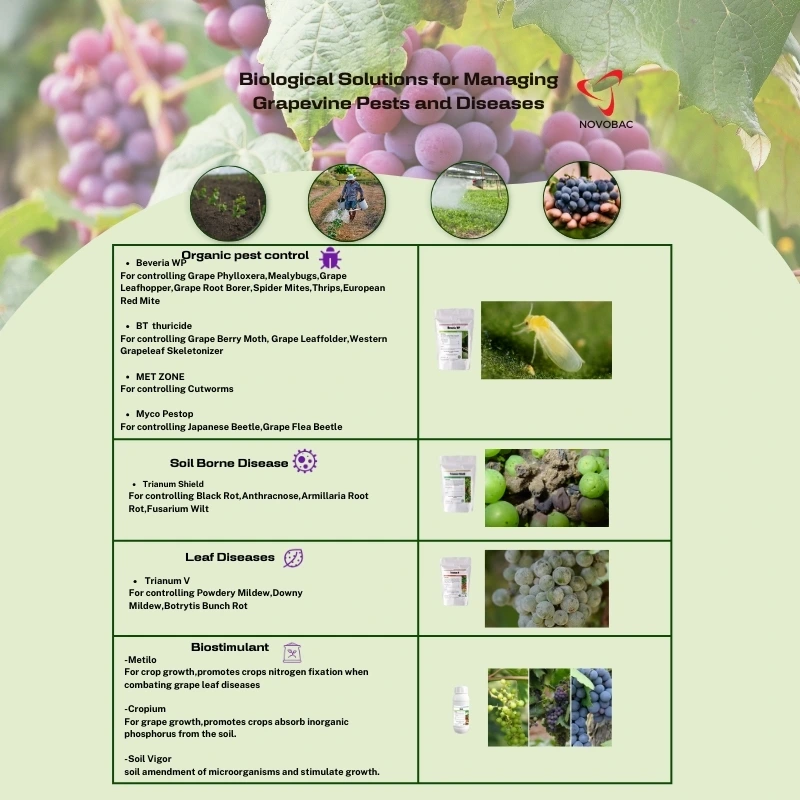
Related Products
CONTACT US

Office 38/1502, No 660,Hanguang Rt., Changsha City, Hunan, China































